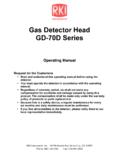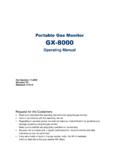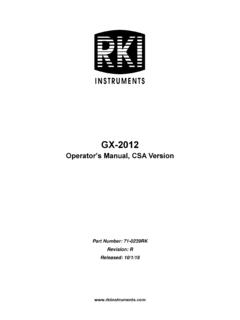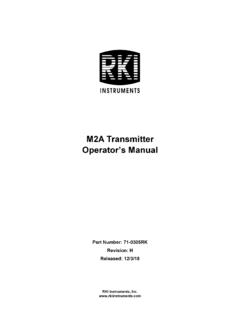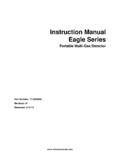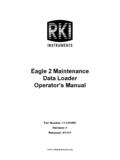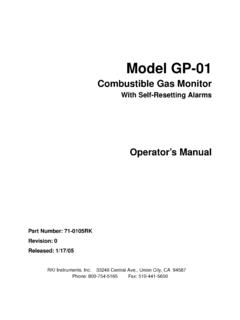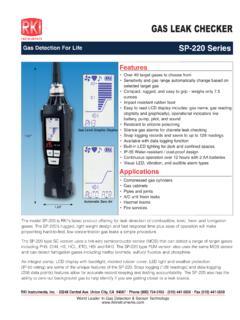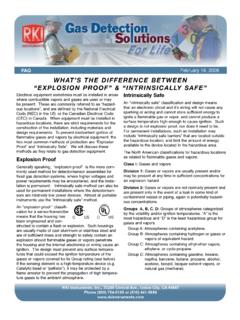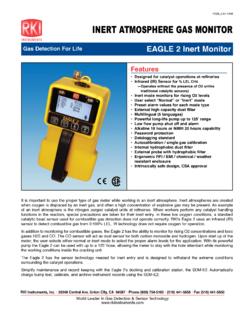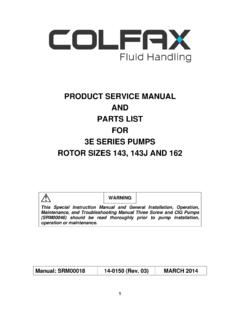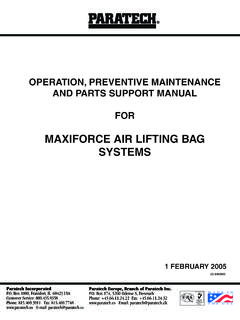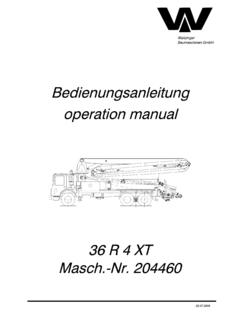Transcription of Instruction Manual Eagle Series
1 Instruction Manual Eagle Series Portable Multi-Gas Detector Part Number: 71-0028RK. Revision: L. Released: 5/16/17. WARNING. Read and understand this Instruction Manual before operating instrument. Improper use of the gas monitor could result in bodily harm or death. Periodic calibration and maintenance of the gas monitor is essential for proper operation and correct readings. Please calibrate and maintain this instrument regularly! Frequency of calibration depends upon the type of use you have and the sensor types. Typical calibration frequencies for most applications are between 1 and 3 months, but can be required more often or less often based on your usage. Eagle Instruction Manual Warranty RKI Instruments, Inc. warranties gas alarm equipment manufactured by RKI and sold by RKI to be free from defects in materials and workmanship for a period of one year from date of shipment from RKI Instruments, Inc. Any parts found defective within that period will be repaired or replaced, at our option, free of charge.
2 This warranty does not apply to items that are subject to deterioration or consumption in normal service, and which must be cleaned, repaired, or replaced routinely. Those items include, but are not limited to: absorbent cartridges filter elements pump diaphragms and valves batteries lamp bulbs and fuses This warranty is voided by mechanical damage, misuse, alteration, rough handling, or repairs not in accordance with the operator's Manual . This warranty indicates the full extent of our liability. We are not responsible for removal or replacement costs, local repair costs, transportation costs, or contingent expenses incurred without our prior approval. THIS WARRANTY IS IN LIEU OF ANY OTHER WARRANTIES AND. REPRESENTATIONS, EXPRESSED OR IMPLIED, AND ALL OTHER OBLIGATIONS. OR LIABILITIES ON THE PART OF RKI INSTRUMENTS, INC. INCLUDING BUT. NOT LIMITED TO THE WARRANTY OF MERCHANTABILITY OR FITNESS FOR A. PARTICULAR PURPOSE. IN NO EVENT SHALL RKI INSTRUMENTS, INC. BE. LIABLE FOR INDIRECT, INCIDENTAL, OR CONSEQUENTIAL LOSS OR DAMAGE.
3 OF ANY KIND CONNECTED WITH THE USE OF ITS PRODUCTS OR FAILURE OF. ITS PRODUCTS TO FUNCTION OR OPERATE PROPERLY. This warranty covers instruments and parts sold to end users by authorized distributors, dealers, and representatives of RKI. Instruments, Inc. We do not assume indemnification for any accident or damage caused by the operation of this gas monitor. Our warranty is limited to replacement of parts or our complete goods. Eagle Instruction Manual Table of Contents Introduction .. 1. Overview .. 1. About this Manual .. 2. Specifications.. 3. Description .. 5. Case .. 5. Control Panel .. 5. Buttons .. 5. Alarm Lights .. 6. Battery Charger Connector .. 6. Interface Port .. 6. Buzzer .. 6. Sample-Drawing System .. 6. Hose and Probe .. 6. Sensors .. 8. Circuit Boards .. 9. Methane Elimination Switch .. 9. CAL/SETUP Switch .. 9. Operation .. 10. Starting Up the Eagle .. 10. Normal Operation.. 12. Monitoring Combustible Gas in the PPM Range .. 12. Monitoring Combustible Gases Other Than Methane.
4 12. Setting User Access .. 14. Turning Off the Eagle .. 14. Alarms .. 15. Alarm Indications .. 15. Resetting Gas Alarms .. 19. Eagle Instruction Manual Display Mode .. 20. User and Station ID Screen .. 20. Peak Screen .. 21. Elapsed Time Screen.. 21. TWA/STEL Screen .. 22. Battery Voltage Screen .. 22. Date/Time Screen .. 22. Clear Data Logger Screens.. 23. Remaining Log Time Screen .. 23. Setup Mode .. 24. Tips for Using Setup Mode .. 24. Entering Setup Mode .. 25. Updating the Battery Type Setting .. 25. Updating Channel Settings .. 26. Updating the Combustible Gas Channel's Units of Measure.. 32. Updating the Alarm Point Settings .. 33. Updating the Eagle 's Serial Number .. 34. Updating the Lunch Break Setting .. 34. Updating the Alarm Latching Setting .. 35. Updating the Alarm Silence Setting .. 35. Turning the User ID Function On or Off .. 36. Updating the Auto Calibration Settings .. 36. Updating the Back Light Setting.. 37. Turning the Auto Fresh Air Function On or Off .. 37. Updating the Interval Time Setting (data log option).
5 38. Updating the Log Data Over Write Setting (data log option) .. 38. Updating the Time Calibration Setting (data log option) .. 39. Updating the Date and Time Settings (data log option) .. 39. Updating the Zero Follow Settings .. 40. Updating the Confirmation Beep Setting .. 40. Returning to Default Settings .. 40. Eagle Instruction Manual Calibration .. 42. Calibration Supplies and Equipment .. 42. Preparing for Calibration .. 43. Calibrating the Eagle .. 43. Maintenance.. 47. Displaying the Battery Voltage .. 47. Replacing Alkaline Batteries .. 47. Recharging Ni-Cd Batteries .. 47. Replacing the Probe's Particle Filter and Hydrophobic Filter Disk.. 48. Replacing Sensors .. 49. Appendix A: Parts List .. 53. Appendix B: Methane Elimination .. 55. Setting up for Methane Elimination Mode .. 55. Operating With Methane Response OFF.. 55. Returning to Methane Response Mode .. 55. Monitoring Combustible Gases Other Than Hexane .. 56. Appendix C: Non-Standard Toxic Gas Sensors .. 57. Specifications.
6 57. Description .. 58. Keeping Fresh Batteries in a Non-Standard Toxic Eagle .. 59. Calibrating Non-Standard Toxic Gas Sensors .. 59. Replacing Non-Standard Toxic Gas Sensors.. 61. Parts List .. 63. Appendix D: Carbon Dioxide Sensors .. 65. Specifications .. 65. Description .. 65. Normal Operation of Carbon Dioxide Sensors.. 66. Demand Zero for Carbon Dioxide Sensors .. 66. Calibrating Carbon Dioxide Sensors .. 67. Replacing Carbon Dioxide Sensors .. 69. Parts List .. 69. Eagle Instruction Manual Appendix E: Infrared Methane Sensors .. 70. Target Gases.. 70. Specifications .. 70. Description .. 70. Calibrating Infrared Methane Sensors .. 71. Replacing Infrared Methane Sensors .. 72. Parts List .. 72. Appendix F: Eagle Tank Tester Model .. 73. Description .. 73. Alarms.. 74. Calibration .. 74. Parts List .. 75. Appendix G: Five-Gas and Six-Gas Models .. 76. Overview .. 76. Displaying Additional Channels .. 76. Alarms.. 77. Calibration, Display, and Setup Modes .. 77. Appendix H: Eagle Transformer Gas Tester.
7 78. Description .. 78. Operation .. 78. Alarms.. 79. Parts List .. 75. Appendix I: Eagle Transformer Gas Tester Model TRB .. 80. Description .. 80. Operation .. 81. Calibration .. 81. Alarms.. 81. Parts List .. 81. Appendix J: Installing the Data Logger Board .. 82. Eagle Instruction Manual Appendix K: Infrared HC Sensor .. 83. Target Gases.. 83. Specifications .. 83. Description .. 83. Calibrating the Infrared HC Sensor .. 84. Replacing the Infrared HC Sensor .. 85. Parts List .. 85. Eagle Instruction Manual Introduction Overview The RKI Eagle is the most advanced portable gas detection system available. The Eagle is built for rugged reliability and ease of use and includes the latest innovations in gas detection technology: Simultaneous detection of one to six gases. Standard target gases include combustible gas (% LEL and ppm), oxygen deficiency, carbon monoxide, and hydrogen sulfide. Powerful sample-drawing pump with up to 125-foot range. Dot-matrix liquid crystal display (LCD) for complete, understandable information at a glance.
8 Microprocessor control for all functions, including data logging and user-adjustable alarms. Visible and audible alarms for hazardous conditions and malfunctions. UL and CSA classified. Intrinsic safety for Class I, Division I, Groups A, B, C, and D hazardous atmospheres (standard 4-gas model and non-standard toxic gas versions). Consult RKI. Instrument, Inc. for classification of other Eagle versions. Tough case with a balanced, light-weight design. WARNING: The Eagle detects a combination of combustible gas, oxygen deficiency, hydrogen sulfide and carbon monoxide, or other toxic gases which can be lethal. When using the Eagle , you must follow the instructions and warnings in this Manual to assure proper and safe operation of the unit and to minimize the risk of personal injury. Be sure to maintain and periodically calibrate the Eagle as described in this Manual . Eagle Instruction Manual Introduction 1. About this Manual This Manual is intended for use with all Eagle models. Examples used in this Manual are for the standard four-gas model (combustible gas, oxygen, carbon monoxide, and hydrogen sulfide).
9 Differences between the standard four-gas model and other Eagle models are noted where applicable. This Manual is organized as follows: The standard sections included in pages 1 through 52 describe the Eagle 's specifications and internal and external components. These sections also describe the operation, calibration, and maintenance of the Eagle . Appendix A lists part numbers for the Eagle 's replacement parts and accessories. Appendix B describes the Eagle 's methane elimination feature. Appendix C describes the non-standard toxic sensors. Appendix D describes the infrared carbon dioxide special sensor. Appendix E describes the infrared CH4 special sensor. Appendix F describes the Eagle tank tester model. Appendix G describes the Eagle 's five- and six-gas models. Appendix H describes the Eagle transformer gas tester model. Appendix I describes the Eagle transformer gas test Model TRB. Appendix J describes the procedure to install the Eagle 's optional Data Logger board. Appendix K describes the infrared HC special sensor.
10 2 Introduction Eagle Instruction Manual Specifications Table 1 lists physical and environmental specifications for the Eagle . Table 2 lists specifications for the Eagle 's standard sensors. Table 1: Eagle Specifications Target Gases1 Combustible gas; Oxygen (O2), Carbon monoxide (CO); Hydrogen sulfide (H2S). Case High-impact polycarbonate-polyester blend Safety/Regulatory2 CSA/NTRL and UL classified intrinsically safe (Class I, Division 1, Groups A, B, C, and D). Dimensions in. x in. x in. ( cm x cm x cm). Weight 5 lbs. ( kg). Power Four D-size batteries (alkaline or Ni-Cd). Continuous Operating Alkaline: 30 hours (minimum). Hours Ni-Cd: 18 hours (minimum)3. Operating Temperature 14 F to 104 F (-10 C to 40 C). Humidity 0 to 95% (non-condensing). Standard Accessories Shoulder strap; alkaline batteries; hydrophobic probe;. 5-foot hose Optional Accessories Ni-Cd batteries; battery charger (115 VAC);. continuous operation adapter (115 VAC or 12 VDC);. dilution fitting (1:1 or 3:1); remote alarm; data logger 1 Appendices C, D, E, and J describe the Eagle 's non-standard sensors.
